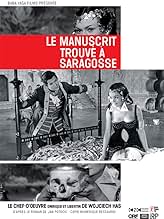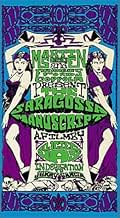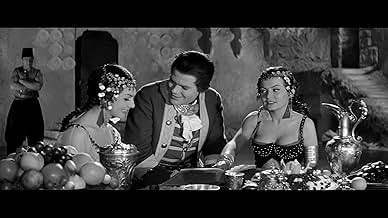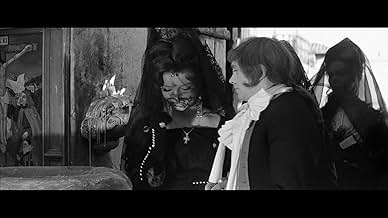Rekopis znaleziony w Saragossie
- 1965
- 3 घं 2 मि
अपनी भाषा में प्लॉट जोड़ेंUpon finding a book that relates his grandfather's story, an officer ventures through Spain meeting a wide array of characters, most of whom have a story of their own to tell.Upon finding a book that relates his grandfather's story, an officer ventures through Spain meeting a wide array of characters, most of whom have a story of their own to tell.Upon finding a book that relates his grandfather's story, an officer ventures through Spain meeting a wide array of characters, most of whom have a story of their own to tell.
- निर्देशक
- लेखक
- स्टार
- पुरस्कार
- कुल 1 जीत
फ़ीचर्ड समीक्षाएं
Its story centers around the efforts by a brave officer in mid-XVIIIth Century Spain to distance himself from ghosts or evil spirits that visit him every night and take the form of two charming Muslim sisters who want to be his lovers and bear his children, even in succubi form, and insist that he convert to Islam. Those erotic (and heretic) reveries also have something to do with devilry and all things forbidden and his encounters with those women are encouraged by the mysterious figure of the Cabalist (another forbidden science) and his sister Rebecca and severely repressed by roaming members of the Catholic Inquisition. This framing story is the pretext for a series of very involving and amusing moral tales told in flashback by several participants, who all echo each other and whose moral seems to be that all religious and social prohibitions and ghost stories should be taken with a grain of salt. In this ocean of mystery and gothicism stands the figure of Don Pedro Velasquez, a mathematician who befriends the hero and who seems the only character to believe in the cold light of reason (foreshadowings of Polanski's "The Fearless Vampire Killers").
After several viewings, the only point in the film which remains mysterious is why Frasqueta's lover (Pena Flor) should appear with a bloodied face when he climbs in her bedroom through a window, a fact the viewer has to provide his own backstory for and which could be evidence that the original film was even longer than the 182 minutes at which it clocks in on the restored DVD edition. (Personal theory: Pena Flor really was Frasqueta's lover and the band of thugs Frasqueta hired to deceive her husband into believing he had paid to have his wife's lover killed really did attempt to kill him before he paid them to kill her husband instead.) Well, that and the fact that Jerry Garcia of the Grateful Dead, an early fan of the film and one the persons responsible for its restoration, was fond of quoting a scene from the film that doesn't seem to exist anymore (a character's confrontation with Death at the foot of his bed, which, according to DVD Savant, could come from the 1960 Mexican film "Macario")...
A WORD ABOUT THE DVD: This film was restored thanks to the efforts and money of Martin Scorsese, Francis Ford Coppola and the above-mentioned Jerry Garcia, and the collaboration of the director. It was shot in Dyaliscope, the French CinemaScope equivalent, which is always projected at a standard 2.35:1 ratio. This "enhanced for widescreen TVs" DVD shows an image with a ratio of 2:1, which means that the picture information is still squeezed by a ratio of 15 % in relation to the way it should be shown normally. In this presentation, the picture is "fish-eyed" and the characters and animals appear too slim. There is no way around this problem if you watch it on a 4:3 television set. However, if you own a widescreen TV, you can set-up your DVD player as for a standard 4:3 TV monitor and gently unsqueeze the resulting picture with any one of the "cheater" modes provided by your TV model to approximate a 2:35 presentation. There is no way of knowing if this drawback is the result of simple ignorance (mistaking the 2:1 squeeze of Dyaliscope with a 2:1 projection ratio) or of a compromise allowing to use the greater part of the TV screen in both 4:3 and 1.77:1 TV sets. It took me along time to figure out this problem and I am glad to share this little trick with you.
This theme is the contribution of the novelist Jan Potocki, a Pole living in France when he wrote "The Manuscript Found in Saragossa" at the beginning of the 19th century. One of the main strengths of the movie is also mainly Potocki's, the creation of a Spain of dreams, full of romance, mystery, lively humor, and eroticism (the novel found difficulty in being published originally, and the author was criticised for his libertinism). As vividly brought to the screen by Wojcech Has, this Spain is a place that a viewer will want to return to repeatedly.
Has, however, strongly emphasized the phantasmagorical elements in the novel. The atmosphere that he creates, and the visual style that supports it, are another major asset of the movie. The images of the haunted Sierra Morena are consistently touched with strangeness but not overburdened. I think especially of one shot where the tumbled white rocks look just like bleached bones -- an effect that wouldn't have worked so well if the movie had been in color. In keeping with this shift of emphasis, the adaptation contributes a new ending to the story, which is entirely appropriate; it comes from a distinctly twentieth-century sensibility.
Add to this a uniformly skillful cast (special recognition goes to Slawomir Lindner as the elder Van Worden) and you have a movie that I can't recommend strongly enough.
By the end of the film, to say the least, the viewer has been presented with a convincing picture of sixteenth-century Europe from different angles, and it's safe to say that no other film, before or since, in color or Black-and-white, has done it better.
क्या आपको पता है
- ट्रिवियाLuis Buñuel, who seldom viewed movies more than once, liked this film so much that he saw it three times.
- भाव
Donna Rebecca Uzeda: All these adventures begin simply. The listener thinks it'll soon be over, but one story creates another, and then another.
Don Pedro Velasquez: Something like quotients which can be divided infinitely.
- इसके अलावा अन्य वर्जनOriginally released in a cut version in the US, the film was restored to it's original 182-minutes running time and premiered at the New York Film Festival in September 1997. The restoration project, supervised by Edith Kramer, was initially sponsored by Grateful Dead's leader Jerry Garcia and later completed by Francis Ford Coppola and Martin Scorsese. The restored version includes a dedication to Jerry Garcia.
टॉप पसंद
- How long is The Saragossa Manuscript?Alexa द्वारा संचालित
विवरण
- रिलीज़ की तारीख़
- कंट्री ऑफ़ ओरिजिन
- आधिकारिक साइट
- भाषा
- इस रूप में भी जाना जाता है
- The Saragossa Manuscript
- फ़िल्माने की जगहें
- Olsztyn, Slaskie, पोलैंड(castle)
- उत्पादन कंपनी
- IMDbPro पर और कंपनी क्रेडिट देखें
बॉक्स ऑफ़िस
- दुनिया भर में सकल
- $13,377
- चलने की अवधि3 घंटे 2 मिनट
- रंग
- ध्वनि मिश्रण
- पक्ष अनुपात
- 2.35 : 1
इस पेज में योगदान दें



































